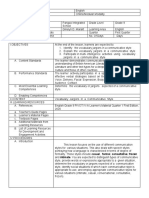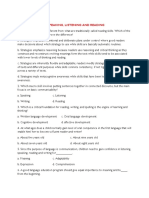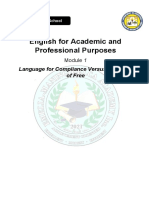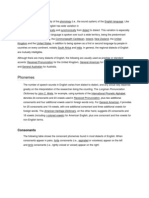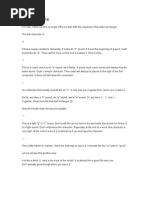Second Preliminary Examination in English 5 July 10, 2017 Test I
Second Preliminary Examination in English 5 July 10, 2017 Test I
Uploaded by
Rachelyn MontejoCopyright:
Available Formats
Second Preliminary Examination in English 5 July 10, 2017 Test I
Second Preliminary Examination in English 5 July 10, 2017 Test I
Uploaded by
Rachelyn MontejoOriginal Description:
Original Title
Copyright
Available Formats
Share this document
Did you find this document useful?
Is this content inappropriate?
Copyright:
Available Formats
Second Preliminary Examination in English 5 July 10, 2017 Test I
Second Preliminary Examination in English 5 July 10, 2017 Test I
Uploaded by
Rachelyn MontejoCopyright:
Available Formats
Second Preliminary Examination in English 5 July 10, 2017
TEST I. Read the following sentences carefully. Write VERDAD if the statement is true and FALSO if the
statement is false.
1. Learners are most likely to achieve more progress if they want to learn.
2. Exposure to the target language has a negative impact to the acquisition of that language.
3. Substitution happens when a sound is replaced by another sound.
4. Fossilized forms are difficult to change and needs to be avoided as early as possible.
5. Through constant practice, learners will develop muscle memory allowing them to pronounce sounds easily.
6. Suprasegmental features include stress, intonation and rhyme.
7. Teachers should not tell all the details of pronunciation to students because they might be too much.
8. Consonants are sounds in which the air stream meets some obstacles on its way up from the lungs.
9. Letters and sounds are not the same thing.
10. Consonants whose points of articulation are the back of the tongue and soft palate are called velars.
11. In producing fricative consonants, the air stream is compressed and passes through an opening creating a hissing.
12. The tongues position in producing vowel sounds could be vertical or horizontal.
13. The musical aspects of pronunciation need to be given consideration in teaching.
14. Segmental features are less important than suprasegmental features.
15. Teachers should not allow second language learners to use connected speech.
TEST II. Analyze the following questions and write the letter of the correct answer on your answer sheets.(2 pts.
each)
1. What should be the goal of teaching pronunciation?
A. Intelligent pronunciation B. native pronunciation C. intelligible pronunciation D. fluency
2. Why should teacher not teach students to speak English like a native speaker does?
A. Because it is very difficult C. Because teachers are not native speakers
B. Because there is no exact definition of a native speaker D. Because it will develop pressure on the students
2. Which among the following does NOT affect the learning of pronunciation?
A. age B. motivation C. teaching strategies D. accuracy
3. Which problem with individual words can cause students to commit pronunciation errors when they use patterning?
A. spelling B. borrowed words C. unfamiliar sounds D. none of these
4. Which among the following consonant sounds does NOT belong to the group?
A. [s] B. [z] C. [] D. //
5. Which among the following is NOT a principle of the communicative framework for teaching pronunciation?
A. Classroom materials should reflect student need and interest.
B. The language instruction should focus on enabling learners to express themselves in varying social interactions.
C. Errors should be minimized as much as possible.
D. Learners should be active participants in the lesson.
6. Why should learners know how vowel sounds differ from each other?
A. So they can avoid errors like merging and substitution. B. So they can practice their tongues in producing them.
B. So they can become fluent in speaking. C. So they can widen their understanding the language.
7. Which of the following is true about connected speech?
A. All speech are connected speech. C. Connected speech can only be used in casual settings.
B. Connected speech cannot be used in formal settings. D. We use connected speech in writing.
8. Which among the following is a minimal pair?
A. glass - grasp B. grasp grip C. span - spam D. bleak streak
9. Which among the following sounds is a bilabial stop?
A. /m/ B. /r/ C. /d/ D. /p/
10. During class discussions about stories, Rosalinda often mispronounces key words from the stories. The teachers best
response would be to:
A. ask Rosalinda to pause and correct her pronunciation before she continues with her remarks.
B. Analyze Rosalindas pronunciation patterns and plan an intervention for her needs.
C. Encourage other students in the class to help Rosalinda work on her pronunciation.
D. Write down the words and include them on a list of words for Rosalinda to practice pronouncing.
11. A second-grade bilingual education teacher modifies his spoken language in class by speaking clearly and slowly,
avoiding confusing idioms, repeating important concepts, and summarizing content frequently. The teacher most likely
makes these modifications to provide students with:
A. models of vocabulary usage. C. background knowledge.
B. comprehensible input. D. examples of standard pronunciation.
12. Which of the following statements best describes why a speaker may have an accent when speaking in a second
language?
A. The speaker is using aspects of the sound system of the first language when speaking in the second language.
B. The speaker's first language has a different grammatical structure from the second language.
C. The speaker's first language shares few cognate words with the second language.
D. The speaker is using the rules for word and sentence structure in the first language when speaking in the second
language.
13. In a classroom that focuses on the development of literacy in both first and second language, which of the following
strategies would best help students transfer literacy skills from the first language into the target language?
A. providing students with ongoing opportunities to build proficiency in their first language
B. allowing students to use first language translations alongside target-language materials
C. encouraging students to supplement target-language materials with first language materials from the Internet or in the
class library
D. dividing students into learning groups based on their level of proficiency in the first language
14. A bilingual education teacher wants to help students who are having difficulty understanding idiomatic expressions in
the target language. The teacher can best help the students understand these expressions by explaining that idiomatic
expressions:
A. have similar equivalents across most languages.
B. can be analyzed like any other grammatical construction.
C. can usually be interpreted by visualizing their content.
D. are best learned and understood within their sociocultural context.
15. An elementary school class contains students who are at varying levels of proficiency in both languages of instruction.
Which of the following instructional strategies would best allow the teacher to promote the literacy development of all
students?
A. establishing small, flexible groups based on students' literacy skills and moving students from group to group as their
literacy skills change
B. creating a pull-out section for students who are performing at the lowest levels in both languages of instruction
C. providing the same literacy assignments to all students, but giving them different amounts of time to complete the
assignments
D. setting up learning centers where students can practice literacy skills in both languages of instruction at their own pace
The hardest thing in life is to learn which bridge to cross and which to burn.
_David Russell
_teacheRachel
You might also like
- Multiple Choice Questions (Lecture 1234)Document7 pagesMultiple Choice Questions (Lecture 1234)Chu Mỹ100% (1)
- 340 Lorimar 2 English Major Reviewer 1 PDFDocument53 pages340 Lorimar 2 English Major Reviewer 1 PDFVanessa Aguilar MarTinNo ratings yet
- Lorimar 2 EnglishDocument53 pagesLorimar 2 Englishmarclyn atiwag67% (3)
- English Majors ReviewDocument37 pagesEnglish Majors ReviewRaulene100% (2)
- G9 MELC3 Lesson ExemplarDocument8 pagesG9 MELC3 Lesson ExemplarGinelyn Maralit100% (1)
- Cheers and YellsDocument2 pagesCheers and YellsRachelyn MontejoNo ratings yet
- ELT2 Midterm 2023Document5 pagesELT2 Midterm 2023ngochan.selfNo ratings yet
- LL1-ANS-KEYDocument14 pagesLL1-ANS-KEYnhatquynh.141005No ratings yet
- 340 ITEMS ENGLISH MAJOR REVIEWER - Vol.2Document53 pages340 ITEMS ENGLISH MAJOR REVIEWER - Vol.2Hernan DigoNo ratings yet
- English Majorship Let Updated Reviewers 2Document81 pagesEnglish Majorship Let Updated Reviewers 2Jane Kiamco100% (1)
- E2 GHP VHVL 2023Document2 pagesE2 GHP VHVL 2023Nguyễn ThơNo ratings yet
- Lorimar 2 English 1Document53 pagesLorimar 2 English 1Glaiza Joy Supat100% (1)
- Facts About English LanguageDocument7 pagesFacts About English LanguageKarylle JadeNo ratings yet
- SkillsDocument4 pagesSkillsBeverly BuhayNo ratings yet
- 0017 - Completed ENGLISH MAJOR 360 ITEMS PART 2 ConvDocument34 pages0017 - Completed ENGLISH MAJOR 360 ITEMS PART 2 ConvAngelo Rebayla OribiaNo ratings yet
- Day 6 Test of ListeningDocument6 pagesDay 6 Test of ListeningKhotim MaslikahNo ratings yet
- QuizDocument10 pagesQuizLại Lê Gia HânNo ratings yet
- Technology: Alcate, Victoria Labasan, Bongabong Masipit, Calapan CityDocument7 pagesTechnology: Alcate, Victoria Labasan, Bongabong Masipit, Calapan CityDherick RaleighNo ratings yet
- Long Test 554 - Arcilla FDocument7 pagesLong Test 554 - Arcilla FAnabelle Gines ArcillaNo ratings yet
- Audio Lingual MethodDocument4 pagesAudio Lingual MethodhayalmezarligiNo ratings yet
- Proposal EvhaDocument31 pagesProposal EvhaEva MeiliaNo ratings yet
- Elt2 Midterm 2024Document3 pagesElt2 Midterm 2024Hà VyNo ratings yet
- CHAPTER I Improving Students' Translation Skill On Lyric Song Through Audio Lingual MethodDocument7 pagesCHAPTER I Improving Students' Translation Skill On Lyric Song Through Audio Lingual MethoddwiNo ratings yet
- LICENSURE EXAMI-WPS OfficeDocument13 pagesLICENSURE EXAMI-WPS Officelarramaemartus4No ratings yet
- Differentiates Language Used in Academic Texts From Various DisciplinesDocument8 pagesDifferentiates Language Used in Academic Texts From Various DisciplinesJhonel Mogueis Dela CruzNo ratings yet
- Q3e LS5 U01A StudentDocument9 pagesQ3e LS5 U01A StudentJniirNo ratings yet
- 01b - Celta QuestionnaireDocument2 pages01b - Celta QuestionnaireDavid Douglas NegreirosNo ratings yet
- SURVEY QUESTIONNAIRE GerardDocument6 pagesSURVEY QUESTIONNAIRE Gerardwendyl sanicoNo ratings yet
- LLDHDocument14 pagesLLDHDương LệNo ratings yet
- Teaching Basic Vocabulary For Kindergarten Students by Using Communicative Language Teaching Method Via GamesDocument8 pagesTeaching Basic Vocabulary For Kindergarten Students by Using Communicative Language Teaching Method Via GamesezrasisilyanfNo ratings yet
- Ma Tefl ThesisDocument94 pagesMa Tefl ThesisArif JavaidNo ratings yet
- Teaching Vocabulary Through Games To Elementary Students - Chapter 2Document12 pagesTeaching Vocabulary Through Games To Elementary Students - Chapter 2yustitiamundy100% (1)
- 3 Beed B Teaching English .Document11 pages3 Beed B Teaching English .Abby CabiloNo ratings yet
- Chapter 1 and Chapter 2 For EappDocument15 pagesChapter 1 and Chapter 2 For EappKelly Monroe100% (1)
- Elt2 Midterm 2022 How To Approach Genre AnalysisDocument3 pagesElt2 Midterm 2022 How To Approach Genre AnalysisTrang HàNo ratings yet
- The Teaching of SpeakingDocument14 pagesThe Teaching of SpeakingClarito100% (1)
- Latihan Soal Before MidtermDocument7 pagesLatihan Soal Before MidtermvanyaNo ratings yet
- Drilling Pedagogik 19 - 11 - 2019 (Part 1)Document8 pagesDrilling Pedagogik 19 - 11 - 2019 (Part 1)aliffadilah12No ratings yet
- Bab 2Document23 pagesBab 2Aji SuhendraNo ratings yet
- 2ND Exam - Elective 1Document3 pages2ND Exam - Elective 1Ricca Joy ArmillaNo ratings yet
- Gen Ed 2Document9 pagesGen Ed 2Hazzel AnnNo ratings yet
- Short Quiz EnglishDocument18 pagesShort Quiz EnglishEdelyn BaluyotNo ratings yet
- Ramelan, 1984. Introduction To Linguistics Analysis. Semarang: IKIP Semarang Press. P .3Document6 pagesRamelan, 1984. Introduction To Linguistics Analysis. Semarang: IKIP Semarang Press. P .3Leo Syafviee100% (1)
- Classroom Language 2Document14 pagesClassroom Language 2Lany Bala100% (1)
- After reading activities.Document5 pagesAfter reading activities.nopersonal1989No ratings yet
- Macro Skills Report Part 2 1Document7 pagesMacro Skills Report Part 2 1Shiela Mae CastinNo ratings yet
- EAPP Module 1Document16 pagesEAPP Module 1reigne bulawinNo ratings yet
- Developmental Reading (Drill)Document3 pagesDevelopmental Reading (Drill)Rommel BansaleNo ratings yet
- SinopsisDocument7 pagesSinopsisSitiNo ratings yet
- English Language Teaching Approaches and Methods: Line Clar RealDocument7 pagesEnglish Language Teaching Approaches and Methods: Line Clar Realtaw realNo ratings yet
- Chapter IDocument30 pagesChapter IandriNo ratings yet
- Skripsi ProposalDocument27 pagesSkripsi ProposalAnita R KusumaNo ratings yet
- LAC Session Guide On Vocabulary DevelopmentDocument26 pagesLAC Session Guide On Vocabulary DevelopmentMary Joy RobisNo ratings yet
- EDU 554 Periodical - ArcillaDocument8 pagesEDU 554 Periodical - ArcillaAnabelle Gines ArcillaNo ratings yet
- Agusan Del Sur College, Inc 1 Exam of 1 Term Name - Year and SubjectDocument7 pagesAgusan Del Sur College, Inc 1 Exam of 1 Term Name - Year and SubjectFretchin Mae Coca50% (2)
- English10 q1 Mod7of7 Evaluatingspokentexts v2Document25 pagesEnglish10 q1 Mod7of7 Evaluatingspokentexts v2Uriel fallarcona MabungaNo ratings yet
- Professional Writing SubjectDocument23 pagesProfessional Writing SubjectDini Dwi HastutikNo ratings yet
- Engish Let Questions 2015Document185 pagesEngish Let Questions 2015Sabalza, Ruffelyn AnnNo ratings yet
- Eng1 Group 1 QuizDocument6 pagesEng1 Group 1 QuizjunsheldalubatanNo ratings yet
- TEACHING ENGLISH MCQ TFhshsDocument14 pagesTEACHING ENGLISH MCQ TFhshsAbby CabiloNo ratings yet
- Elective 1 - Final ExamDocument3 pagesElective 1 - Final ExamRicca Joy ArmillaNo ratings yet
- E Ements: F CT ONDocument23 pagesE Ements: F CT ONRachelyn MontejoNo ratings yet
- Grade 8 English ExamDocument3 pagesGrade 8 English ExamRachelyn MontejoNo ratings yet
- Effectiveness of The Use of EOPDocument2 pagesEffectiveness of The Use of EOPRachelyn Montejo83% (12)
- SCs MVPs - EditedDocument1 pageSCs MVPs - EditedRachelyn MontejoNo ratings yet
- Bolinao at Its Best - EditedDocument1 pageBolinao at Its Best - EditedRachelyn MontejoNo ratings yet
- First Periodical Examination in English 8 August 17, 2017Document3 pagesFirst Periodical Examination in English 8 August 17, 2017Rachelyn MontejoNo ratings yet
- Semi-Final Examination in Education 7 March 9-10, 2017: Set ADocument6 pagesSemi-Final Examination in Education 7 March 9-10, 2017: Set ARachelyn MontejoNo ratings yet
- Contempo Summative TestDocument2 pagesContempo Summative TestRachelyn MontejoNo ratings yet
- Report AdrianoDocument23 pagesReport AdrianoRachelyn MontejoNo ratings yet
- DLL Week 5 English Quarter 2Document9 pagesDLL Week 5 English Quarter 2ace magtanongNo ratings yet
- R Controlled VowelsDocument9 pagesR Controlled VowelsABHISHEK GOUTAMNo ratings yet
- Standarts of English in AfricaDocument27 pagesStandarts of English in AfricaEliane MasonNo ratings yet
- Dialectology of District and City in BangkalanDocument12 pagesDialectology of District and City in BangkalanAlditsa Fuad Sii AgedasNo ratings yet
- 14 Phonics Rules For Reading and SpellingDocument15 pages14 Phonics Rules For Reading and SpellingkamrunnisaNo ratings yet
- Aspects of Connected Speech 1Document11 pagesAspects of Connected Speech 1Cristian Rubio Cisterna100% (1)
- Phonemes: English Phonology Is The Study of The Phonology (I.e., The Sound System) of The English Language. LikeDocument19 pagesPhonemes: English Phonology Is The Study of The Phonology (I.e., The Sound System) of The English Language. LikeSkill ××No ratings yet
- Let's Watch This Film-Clip.: - Positive FormDocument17 pagesLet's Watch This Film-Clip.: - Positive Formsandra Acosta ZambranoNo ratings yet
- Session FourDocument8 pagesSession FourNur AsiahNo ratings yet
- BaybayinDocument4 pagesBaybayinBernadet Dela CruzNo ratings yet
- Speech Therapy LessonsDocument40 pagesSpeech Therapy LessonsHajra Halilović100% (3)
- 1st Term NewDocument94 pages1st Term NewAdewusiNo ratings yet
- J 00018 Paper I Set P With KeyDocument44 pagesJ 00018 Paper I Set P With KeyChaitanya KirtiNo ratings yet
- RIMT University: (MCQ) (All Questions Are Compulsory) 01 12 12 MarksDocument3 pagesRIMT University: (MCQ) (All Questions Are Compulsory) 01 12 12 MarksĐěěpâķ ŠîňğhNo ratings yet
- Connected SpeechDocument12 pagesConnected SpeechHenry MaierNo ratings yet
- Mishler - Sanskrit PronunciationDocument8 pagesMishler - Sanskrit Pronunciationsimple21No ratings yet
- Learn HangulDocument11 pagesLearn HanguldesireeuNo ratings yet
- Hindi CommunicationDocument141 pagesHindi CommunicationnajibNo ratings yet
- African Origins of Sino-Tibetan Languages: Evidence From Comparative Lexical and Archaeological Data With Statistical Analyses and Historical-Cultural NotesDocument1,053 pagesAfrican Origins of Sino-Tibetan Languages: Evidence From Comparative Lexical and Archaeological Data With Statistical Analyses and Historical-Cultural NotesThomas P. McGinn33% (3)
- B.A. (Gen. English)Document156 pagesB.A. (Gen. English)sandiNo ratings yet
- PHONETICSDocument2 pagesPHONETICSNatalia SzkopNo ratings yet
- Resumen para Final de Fonetica Inglesa 1Document67 pagesResumen para Final de Fonetica Inglesa 1Sofia FloresNo ratings yet
- One Word UtterancesDocument10 pagesOne Word UtterancesThea NunungNo ratings yet
- 1st Term CADocument7 pages1st Term CAiyokhuneternalNo ratings yet
- Phonological ProcessesDocument1 pagePhonological Processesapi-240681355No ratings yet
- Routledge Handbookof Asian LinguisticsDocument94 pagesRoutledge Handbookof Asian LinguisticsDorian MintNo ratings yet
- Callan Book 1 (Stage 1) .Doc - Documentos GoogleDocument25 pagesCallan Book 1 (Stage 1) .Doc - Documentos GoogleLucas Moraes100% (2)
- Eng 841Document90 pagesEng 841efe noelNo ratings yet
- Topic:: Permutation and CombinationDocument27 pagesTopic:: Permutation and Combinationshiven27No ratings yet





